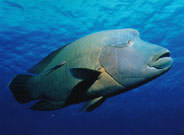Home to over 1500 different species of tropical fish and other variants, the Great Barrier Reef is teeming with life. The reef is home to fish of both of ends of the spectrum- from small bait fish through to the largest varieties of sharks on earth. The sheer volume and density of fish varieties which can be found within a small area make the reef a diver and snorkeler‘s paradise. It is not uncommon to encounter hundreds of different species of fish within a single area of the ocean. Despite the staggering quantities of fishes that dwell within its waters, the fish of the Great Barrier Reef are divided up in to surprisingly few main families, each with significantly differing characteristics that mark the difference from one family to the next.
There are several main factors that signify each major group, including (but not limited to) their size, colour, shape and behaviour. Thus, the major families of fish species that can be found in the waters of the Great Barrier Reef include:
Angelfish
Known for their distinctive shape and often strikingly colourful markings, Angelfish are one of the more numerous species of fish in the Great Barrier Reef, with over 80 different species in the family in total. Typical characteristics of the Angelfish include their beauty, inquisitive nature, and tendency to be found in all levels of the upper reef, from the surface to the base of the area’s coral formations. Patterns which can be found on Angelfish range from thin, vivid stripes to multi-coloured speckled patterns that make no two fish of the families look exactly alike, and they form a bulk of the subjects for underwater photography for enthusiasts on the Great Barrier Reef.
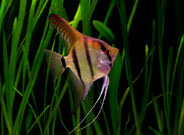
Butterfly Fish
A close relative of the Angelfish, Butterfly Fish share many physical characteristics but are typically distinguished from Angelfish due to their more elongated, thinner “noses” which tend to jut out from their main body. Similarly vibrantly coloured and patterned (with the dominant colour usually a bright yellow), they add colour to what is already a vivid tapestry of rainbow-coloured marine creatures.The bodies of Butterfly Fish are very thin, which help them navigate through smaller passages so that they can dine on their usual diet of coral polyps or algae growing on the reef. Butterfly Fish are also known for being incredibly loyal to their mates, and stay with them for life.

Cardinal Fish
A small, elusive species, Cardinal Fish have large eyes and mouths for their size and are notable to having their dorsal fin separated from a single protrusion into twin fins, a relative rarity among reef-dwelling fishes. Cardinal Fish are nocturnal and typically bury themselves within gaps in coral or caves during the daylight hours before emerging at night to get their fill of their typical shrimp and crab based diet. In terms of coloration, those of the Cardinal Fish are often relatively inconspicuous which is a contributing factor to their ability to evade the many larger predators that inhabit the same waters.

Clown Fish
Also known as Anemone fish, Clown Fish have recently sprung to international fame due to Disney/Pixar’s hit CGI movie Finding Nemo. Anemone fish are extremely popular with the diving community, and Clown Fish in particular are characterised by their highly recognisable markings, typically with a bright orange colouring coupled with a glowing white or light blue band. Their habitats are the sea anemones from which they derive their name, having built up an immunity to the otherwise poisonous tentacles of these soft ocean plants via coating themselves in a layer of mucous. This acts as a natural defence system against passing predators, as the Clown Fish can nestle itself amongst the anemones which will poison any overaggressive threats to the fish – a truly symbiotic relationship. While they are small in size, Clownfish are also popular for being one of the most accessible species of fish in the Great Barrier Reef due to their tendency to inhabit shallower waters, making them often visible by snorkelers without needing to dive down further into the reef’s depths.

Damselfish
From stunning bright colours to drab, muted hues, Damselfish are one of the most common species found in the Great Barrier Reef and can be seen virtually everywhere. Damselfish are surprisingly territorial for their size and diverse coloration. They typically stake out a designated “home” amongst the coral reef which they will then defend with their lives often against predators much larger than themselves. Depending on subspecies their diet consists of either plankton or algae, with the plankton eaters typically having brighter colours and the algae feeders being duller shades of orange and brown.
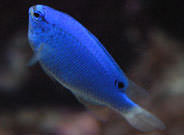
Gobies
Gobies are a huge family of fish that are tiny in size and with short lifespans. Unfortunately for the Gobies, they perform a sympathetic yet essential function within the ecosystem of the Great Barrier Reef as they act as prey for a large number of predators within the same habitat. Gobies mainly reside at the bottom levels of the reef and typically travel either alone or in small groups so as to avoid detection from predators.

Groupers and Cods
These large, slow, plodding reef dwellers are characterised by their stout bodies and large mouths, and are some of the largest fish that can be found in the Great Barrier Reef, with the largest members growing to a length of up to 270 centimetres and weighing in at over 400 kilograms. Fortunately they are harmless and actually fairly social creatures, making for great photo opportunities for scuba divers dating back to recent memory. While visually they are usually quite subdued in colour consisting of mainly speckled greys and browns, their sheer size and docile nature more than makes up for it – and their numerous quantity means that venturing into some of the reef’s deeper areas will almost surely yield an encounter with a grouper of some description.
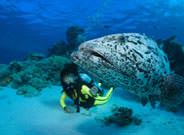
Parrotfish
What could a fish possibly have in common with a parrot? Upon seeing a Parrotfish the first time, it will immediately become apparent – their mouths have a distinct resemblance to a parrot’s beak, which they use to bite off hard sections of coral. Being basically a “medium-sized” reef dwelling fish and with multiple bright coloured patterns on their bodies being the norm, they are one of the most visible species in the Great Barrier Reef and help fill the waters they inhabit with a bevy of additional colour. Contributing to their conspicuous nature is the fact that they live in relatively shallow sections of the reef’s waters, making them a frequent sight spotted by snorkelers adventuring in the Great Barrier Reef. Parrotfish also have one peculiar habit that helps contribute to the development and growth of the reef itself – they use their beaks and teeth to grind up coral and then excrete it as sand which helps in time to create small islands and sandy beaches throughout the world.
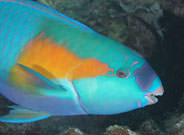
Sharks
Over 160 species of shark inhabit its waters and reefs, however, they are sometimes unfairly labeled as dangerous predators. Despite their reputation they rarely seek to attack humans. While they can indeed be efficient killing machines, this is usually only the case when seeking their prey. Not all sharks are as aggressive as the Great White Shark. The most common species of shark found in the Great Barrier Reef is the White-tipped Reef Shark, a generally passive shark that grows to a maximum of two metres. Another species that is far more recognisable is the Hammerhead, due to its – you guessed it – elongated hammer-shaped head that provides the shark with enhanced vision when seeking prey. Hammerheads can grow up to four metres in length and rarely attack swimmers although they are not overly aggressive. That title in the Great Barrier Reef falls to the Tiger Shark. Tiger Sharks can reach lengths of five metres, and they are opportunistic predators at the top of the food chain that take whatever they may come across including large fish, mammals and even birds.
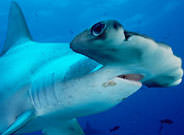
Surgeonfish
Some of the most visually striking fish in the entire Great Barrier Reef, with vivid colours combined with patterns and stripes being the norm with the species and as a result are highly popular fish for people to keep in home aquariums. Surgeonfish derive their name from their spiked blade and venomous fin spines which protrude from their bodies and they use to protect themselves from both predators and fellow members of the same species when engaging in territorial disputes. Large, colourful schools of surgeonfish are a frequent sight on the reef and are the subject of many postcards and magazine photo shoots looking to promote the reef, and with good cause – a school of surgeonfish swimming in unison is the equivalent of an ocean-dwelling, moving rainbow!
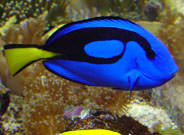
Triggerfish
Brightly-coloured and with a distinctive, “pouty” mouth, Triggerfish are one of the most easily recognisable species of fish on the Great Barrier Reef. Lines, spots and a myriad of other patterns that vary from one fish to another are a hallmark of the Triggerfish family, and as such much like Surgeonfish they are another popular feature of aquariums the world over. Aside from their appearance, Triggerfish are (in)famous for their tempers, being overly aggressive and often biting fish and even people that dwarf them in size. They have strong jaws which they use to feast on a diet of such hard-bodied sea entities as molluscs, sea urchins and other crustaceans, and thus their bite can pierce quite deeply when biting down on human skin.
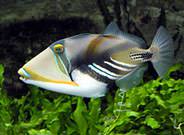
Trout
Coral Trout are one of the most popular catches for fisherman dropping a line in the Great Barrier Reef’s waters due to their ability to fetch a high price on overseas markets as well as their taste. Coral Trout rank fairly high on the reef’s food chain themselves, with a diet that includes many other smaller fish (with Damselfish being a particular favourite.) One of the most visually stunning attributes of the Coral Trout is the male’s ability to instantly change its colour when putting on displays of courtship attempting to land a female, an amazing spectacle to witness when scuba diving. Depending on species, Coral Trout typically grow anywhere from 70 to 120 centimetres in size, and thus are one of the larger common denizens of the Great Barrier Reef.

Wrasse
The most common species of Wrasse found in the Great Barrier Reef is the Humphead or Maori Wrasse, a fish with a very distinctive feature – the large hump on their forehead. They are one of the largest fish found in the reef and can be identified by not only the forehead but also their thick “lips”. Maori Wrasse are also one of the longest-lived fish in the entire Great Barrier Reef, with many known to live upwards of 30 years of age. In spite of this fact, they are currently listed as an endangered species due to their reputation for being a delicious meal and were previously heavily fished. Maori Wrasse can grow up to two metres in length, and combined with their unique colouring and distinctive forehead are one of the most sought-after fish for divers in the reef’s waters off the coast of such destinations as Cairns and Port Douglas.
